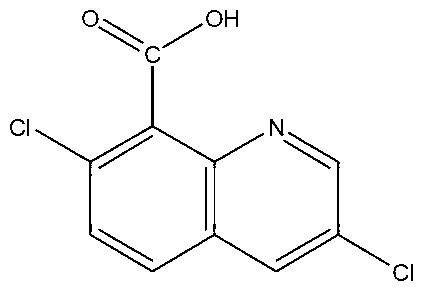Quinclorac degrading bacteria and application thereof
A technology of quinclorac and degrading bacteria, applied in the field of biological treatment of environmental pollutants, can solve the problems of slow degradation, affecting the yield and quality of tobacco leaves, and having no protective effect, and achieves the effect of preventing and controlling phytotoxicity
- Summary
- Abstract
- Description
- Claims
- Application Information
AI Technical Summary
Problems solved by technology
Method used
Image
Examples
Embodiment 1
[0024] Example 1 Screening and activity detection of degrading bacteria J3
[0025] In this experiment, a degrading bacterium with good degrading ability to quinclorac was isolated from three soil samples collected for long-term application of quinclorac by means of enrichment culture and smearing, and it was named for J3. Electron micrographs of strain J3 as figure 1 shown.
[0026] Three soil samples were collected from the paddy fields and tobacco fields near Hunan Agricultural University and the outfall of a pesticide factory in Hunan. ); Tobacco field soil near Hunan Agricultural University (J).
[0027] Enrichment of quinclorac acidolytic bacteria: 5g of each soil sample was added to 50mL inorganic salt medium containing 100mg / L quinclorac, and cultured with shaking at 30°C and 180r / min for one week. Afterwards, the inoculation amount of 4% (volume fraction) was inserted into the freshly sterilized inorganic salt medium, transferred once a week, the concentration of ...
example 2
[0032] Identification of Example 2 bacterial strain J3
[0033] Morphological and physiological and biochemical characteristics of J3: The colony and single bacterial morphology of strain J3 were observed by microscope and scanning electron microscope. The physiological and biochemical identification of J3 uses a kit (single-box biochemical identification tube, produced by Guangdong Huankai Microbial Technology Co., Ltd.).
[0034] Determination of the 16S rDNA sequence of J3: the DNA of the degrading bacteria was extracted using a kit (DNA extraction kit, produced by Beijing Quanshijin Biotechnology Co., Ltd.), and the amplification primers used were synthesized by Huada Gene Company:
[0035] The upstream primer is 5'-AGAGTTTGATCMTGGCTCAG-3';
[0036] The downstream primer is 5'-TACGGCTACCTTGTTACGACTT-3'.
[0037] The amplification reaction system is: 10×Buffer (Mg 2+ ) 4 μL, dNTPs 3 μL, each primer 1 μL, cell DNA 2 μL, Taq DNA polymerase 1 μL, add deionized water to 50 μ...
example 3
[0042] Research on the degradation characteristics of example 3 degrading bacteria J3
[0043] The influence of culture time on the growth and degradation rate of degrading bacteria J3: Prepare 600ml inorganic salt medium and divide it into four 300ml Erlenmeyer flasks (150ml each), set one Erlenmeyer flask as CK, and the other three as three Repeat, adjust the pH to 7.0-7.2, and sterilize for later use. Add quinclorac to the sterilized Erlenmeyer flask to make the concentration 50mg / L, and insert the activated degrader into the other three Erlenmeyer flasks except CK with 4% inoculum (OD600=0.42). Bacteria J3 was then placed in a constant temperature shaker at 30°C and 150r·min-1 for shaking culture. Samples were taken every 24 hours to determine the OD600 value and degradation rate changes.
[0044] The effect of the initial concentration of quinclorac on the growth and degradation rate of degrading bacteria J3: prepare 2700ml inorganic salt culture medium and divide them ...
PUM
| Property | Measurement | Unit |
|---|---|---|
| concentration | aaaaa | aaaaa |
Abstract
Description
Claims
Application Information
 Login to View More
Login to View More - R&D
- Intellectual Property
- Life Sciences
- Materials
- Tech Scout
- Unparalleled Data Quality
- Higher Quality Content
- 60% Fewer Hallucinations
Browse by: Latest US Patents, China's latest patents, Technical Efficacy Thesaurus, Application Domain, Technology Topic, Popular Technical Reports.
© 2025 PatSnap. All rights reserved.Legal|Privacy policy|Modern Slavery Act Transparency Statement|Sitemap|About US| Contact US: help@patsnap.com



